Birdfinding.info ⇒ Across much of the world’s tropical and subtropical oceans, one of the three forms (or species) of Brown Booby is the predominant booby of coastal waters, often perching on ships, buoys, channel markers, and other nautical infrastructure, generally tolerant of boats and other disturbances. The “Atlantic Booby” is common in much of the Caribbean, especially from Puerto Rico to the Leeward Islands, and separately in southeastern Brazil, Cape Verde, and São Tomé & Príncipe. “Forster’s Booby” is locally common in several parts of its large range, including coastal waters of the Red Sea, northern Taiwan, southwestern Japan, Queensland, Hawaii, and French Polynesia. The eastern Pacific form, “Brewster’s Booby”, is common along much of Mexico’s coastline, including the Gulf of California and popular resort towns such as La Paz, Mazatlán, Puerto Vallarta, Manzanillo, Zihuatanejo, and Puerto Angel, south to coastal Colombia.
Brown Booby
Sula leucogaster
Pantropical. Occurs in both inshore and offshore waters. Three distinct forms are recognized, and might be more appropriately reclassified as separate species:
“Atlantic Booby” (leucogaster): Caribbean and Atlantic.
“Forster’s Booby” (plotus): Indian and western and central Pacific.
“Brewster’s Booby” (brewsteri): eastern Pacific.
Breeding. Nests mainly on rocky islets and cliff ledges, but also uses flat, open ground on remote islands.
“Atlantic Booby” breeds on islands of the Caribbean (Yucatán and Bahamas south to Panama and Tobago) and the tropical Atlantic: Cape Verde and islets off of Senegal and São Tomé & Príncipe, as well as Ascension, St. Helena, and both offshore and coastal Brazilian islands from Fernando de Noronha south to Santa Catarina.
“Forster’s Booby” breeds on islets in the Red Sea and at a few scattered sites in the Indian Ocean, on various islets of northern Australia, and in the Pacific Ocean from Taiwan, southern Japan, and the Philippines east across Micronesia, Palau, the Bismarck Archipelago, New Caledonia, Melanesia, and Polynesia to Hawaii and the Marquesas.

“Atlantic Booby” breeding colonies mapped in the West Indian Breeding Seabird Atlas, 2009. © Will Mackin & David Lee

“Atlantic Booby”, S. l. leucogaster, male and female resting near nesting area in Brazil’s Fernando de Noronha archipelago—note female’s paler, whiter feet and facial skin. (May 23, 2010.) © Vítor Piacentini
“Brewster’s Booby”: breeds on Mexican islands north to Los Coronados, throughout the Gulf of California and at scattered sites south along the Pacific Coast of Central America to Colombia, and offshore on the Revillagigedo archipelago, Clipperton, and Cocos Island (Costa Rica).
Nonbreeding. Largely resident around its breeding grounds, and small numbers also disperse nearly throughout the world’s tropical seas, both inshore and offshore.
Vagrants regularly wander north to northern Japan, southeastern Alaska, and Nova Scotia, inland in eastern Texas and the lower Mississippi Valley, south in Brazilian waters to Rio Grande do Sul, and along West African coasts north to Western Sahara and south to Gabon, and south to New South Wales and North Island (New Zealand).
More exceptional vagrants have been recorded in the interior of North America, north to the Kamchatka Peninsula, the Aleutian Islands, southern Labrador, the British Isles (Cornwall and Ireland), Mallorca, and northern Italy.
Identification
Adults of all forms have the same distinctive pattern: dark brown overall, with a crisply defined bright white belly and underwing linings, and pale bill and feet.
Females of the three forms are nearly identical, with only subtle differences in bare parts coloration and underwing pattern, while the males are much more distinctive.

“Atlantic Booby”, S. l. leucogaster, male. (Fernando de Noronha, Brazil; March 25, 2017.) © Eduardo Augusto Ferreira
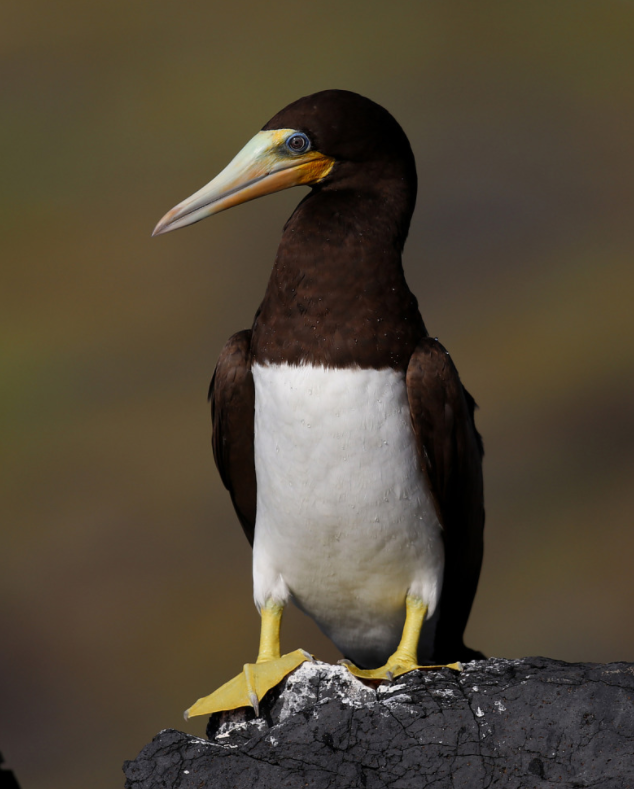
“Atlantic Booby”, S. l. leucogaster, male showing orange-yellow facial skin and small dark, eyeshadow mask. (Fernando de Noronha, Brazil; March 9, 2020.) © Henrique Langenegger
“Atlantic Booby”. Male “Atlantic” typically has mostly yellow-orange facial skin with a dark spot in front of the eye, a horn-colored or straw-yellow bill, often with a slight bluish tint, and yellow-orange feet. The male’s orbital skin is typically bluish and merges with the dark spot in front of the eye to form a small “eyeshadow” mask.
Female “Atlantic” typically has a pale, slightly pinkish bill, pale yellow facial skin with a dark spot in front of the eye, and pale yellow feet. The female’s facial skin and feet are usually a paler shade of yellow (more whitish, less orange) than the male’s, but this coloration varies and can also be orangish like the typical male’s. Unlike males, the female’s orbital skin (immediately around the eye) is pale-yellow.

“Atlantic Booby”, S. l. leucogaster, female. (Lighthouse Trail, Cayman Brac; April 13, 2019.) © Denny Swaby

“Atlantic Booby”, S. l. leucogaster, female. (Fernando de Noronha, Brazil; February 27, 2014.) © Luiz Kagiyama
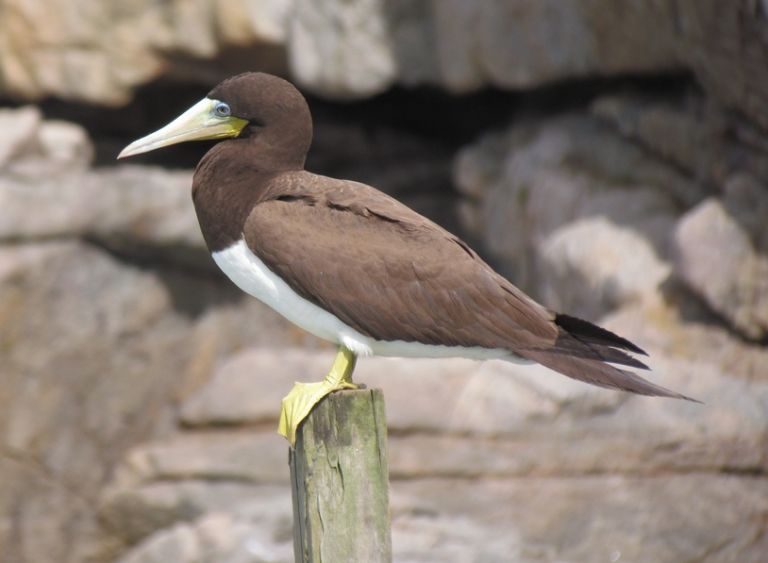
“Atlantic Booby”, S. l. leucogaster, male showing noticeable contrast between darker hood and paler-brown upperparts. (Arraial do Cabo, Rio de Janeiro, Brazil; January 11, 2012.) © Mateus Sales

“Atlantic Booby”, S. l. leucogaster, male. (Ilhabela, São Paulo, Brazil; June 13, 2015.) © Hector Bottai
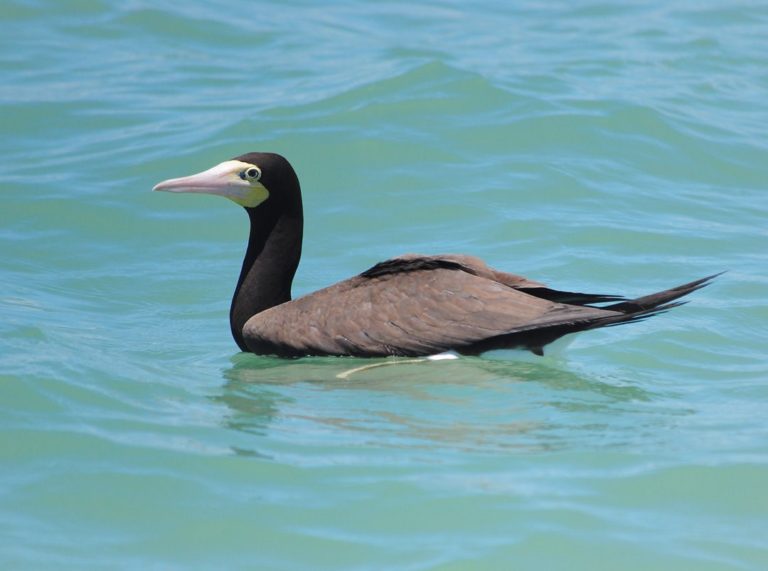
“Atlantic Booby”, S. l. leucogaster, female. (Nova Viçosa, Bahia, Brazil; February 16, 2009.) © Fernando Araújo
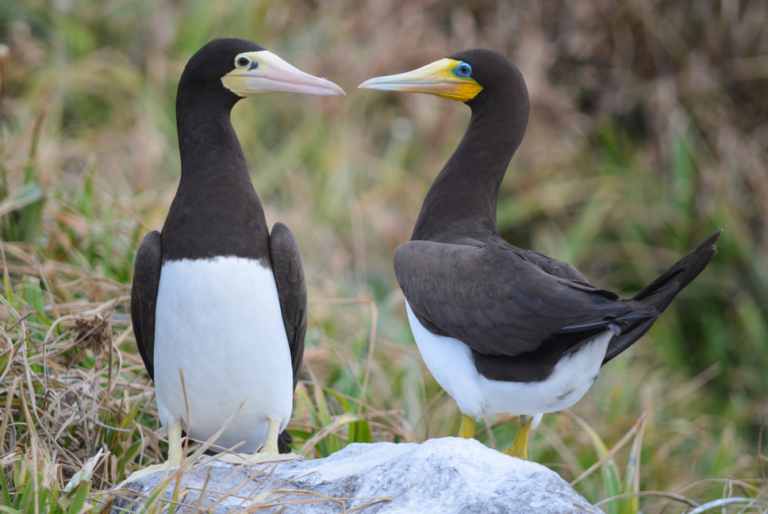
“Atlantic Booby”, S. l. leucogaster, female and male—note female’s paler, whiter feet and facial skin, and compare female’s yellow orbital skin with the male’s vivid blue. (Ilha de Currais, Paraná, Brazil; February 21, 2014.) © Raphael Nunes

“Atlantic Booby”, S. l. leucogaster, female and male—note the female’s pinkish bill contrasting with the male’s horn-colored, bluish tinted bill. (Cayman Brac; November 18, 2010.) © Brian Davis
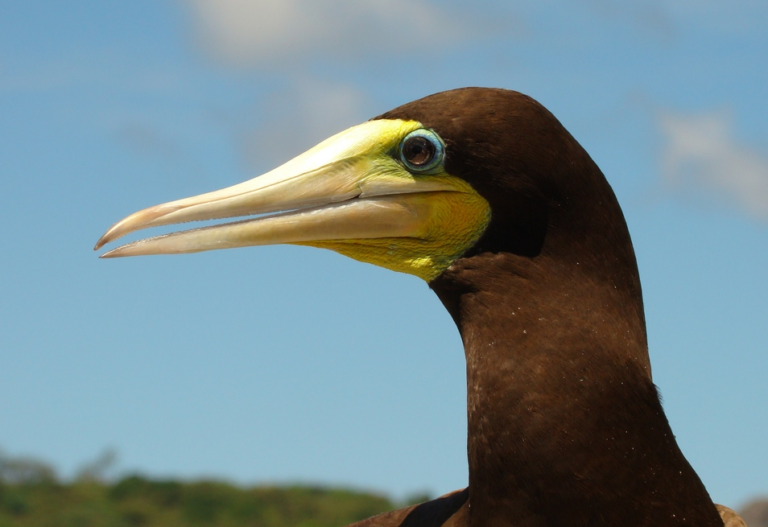
“Atlantic Booby”, S. l. leucogaster, male. (Fernando de Noronha, Brazil; March 22, 2011.) © Rafael Antunes Dias

“Atlantic Booby”, S. l. leucogaster, female. (Fernando de Noronha, Brazil; April 27, 2017.) © Robson Czaban
“Forster’s Booby”. Male “Forster’s” typically has extensively blue facial skin and a horn-colored or straw-yellow bill, often with a slight bluish tint, and pale greenish-yellow feet.
Female “Forster’s” typically has a pale, slightly pinkish bill, pale greenish-yellow facial skin with a dark spot in front of the eye, and pale greenish-yellow feet.
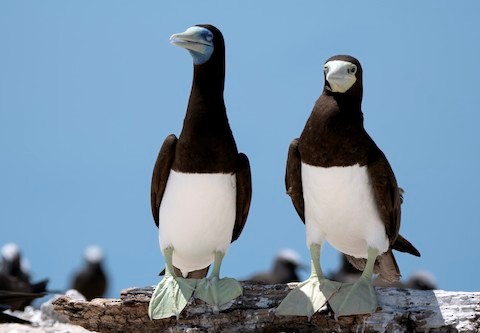
“Atlantic Booby”, S. l. leucogaster, females. (Fernando de Noronha, Brazil; December 4, 2009.) © Rafael Ritter

“Forster’s Booby”, S. l. plotus, male showing maximally blue facial skin. (Michaelmas Cay, Queensland, Australia; January 5, 2017.) © Terence Alexander

“Forster’s Booby”, S. l. plotus, female on nest. (Michaelmas Cay, Queensland, Australia; October 12, 2019.) © Nik Mulconray
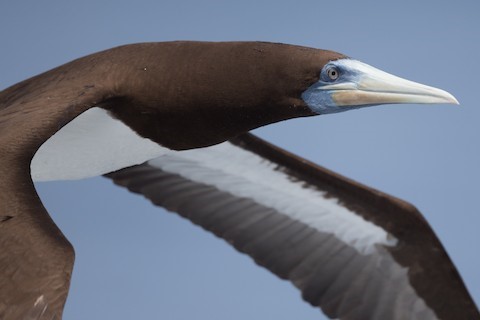
“Forster’s Booby”, S. l. plotus, male, showing blue facial skin. (Offshore south of Chichijima, Ogasawara Islands, Japan; August 5, 2020.) © Yann Muzika

“Forster’s Booby”, S. l. plotus, male showing typically blue facial skin. (Michaelmas Cay, Queensland, Australia; September 25, 2020.) © Scott Fox

“Forster’s Booby”, S. l. plotus, female, showing pinkish bill and pale greenish-yellow facial skin and feet. (Offshore from from Kailua-Kona, Hawaii; September 25, 2016.) © Brian Sullivan

“Forster’s Booby”, S. l. plotus, female with chick. (Michaelmas Cay, Queensland, Australia; January 5, 2017.) © Terence Alexander

“Forster’s Booby”, S. l. plotus, male, showing blue facial skin. (Michaelmas Cay, Great Barrier Reef, Queensland, Australia; December 2, 2017.) © Ian Davies
“Brewster’s Booby”. Male “Brewster’s” is the most distinctive, as it has a contrastingly pale head: white on the face and shading progressively to dark brown on the neck.
The extent of the pale head plumage varies. In some individuals (more prevalent in the Mexican brewsteri rather than the more southerly etesiaca populations), the entire head and most of the neck are pale.
The male’s facial skin is dark blue, which contrasts with the white facial plumage and gives it a masked appearance.
Female “Brewster’s” typically has a pale pinkish bill, pale greenish-yellow facial skin with a dark spot in front of the eye, and pale greenish-yellow feet.
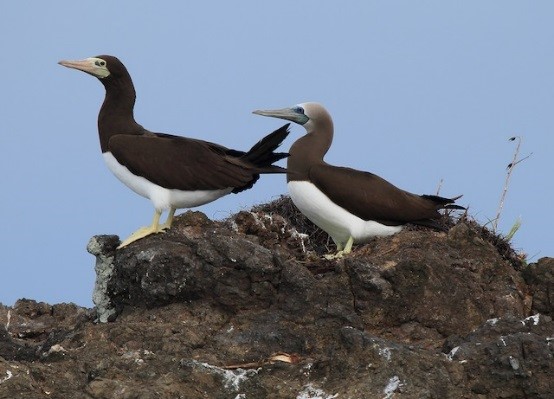
“Brewster’s Booby,” S. l. etesiaca, female and male. (Coiba National Park, Panama; June 15, 2014.) © Fabio Olmos

“Brewster’s Booby,” S. l. etesiaca, male. (Punta Salsipuedes, Puntarenas, Costa Rica; March 7, 2020.) © Irene Domhoff
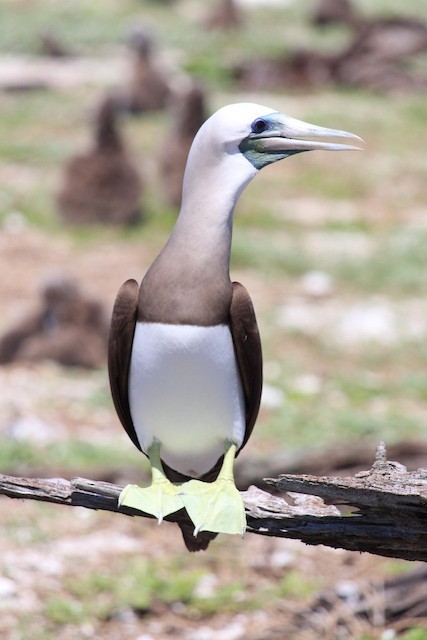
“Brewster’s Booby”, S. l. brewsteri, male. (Eastern Island, Midway Atoll National Wildlife Refuge, Midway Islands; April 9, 2017.) © Lonnie Sullivan

“Brewster’s Booby”, S. l. brewsteri, female. (Isla Pajarera, Jalisco, Mexico; December 29, 2017.) © alexordorica
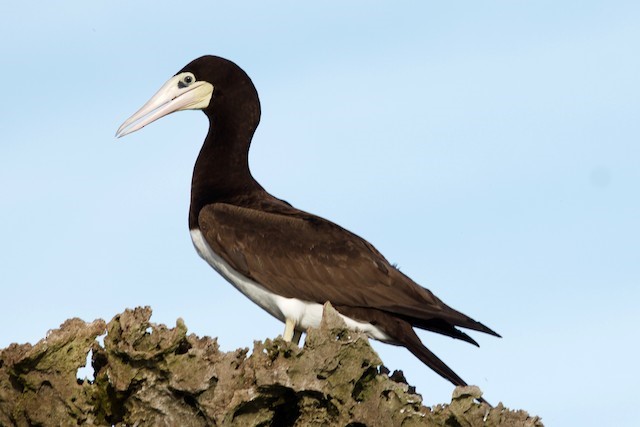
“Brewster’s Booby,” S. l. etesiaca, female. (Swan Cay, Panama; September 8, 2018.) © Natalia Decastro González
In Flight. On all three forms, when viewed dorsally in flight, the upperparts are all-brown, but the head and neck usually appear darker, contrasting with the rest.
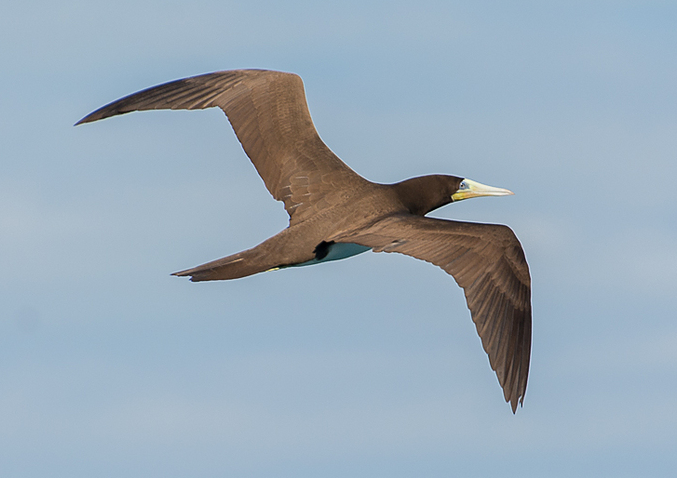
“Atlantic Booby”, S. l. leucogaster, male showing darker hood contrasting with paler-brown upperparts. (Florianópolis, Santa Catarina, Brazil; July 26, 2014.) © Rodrigo von Mühlen
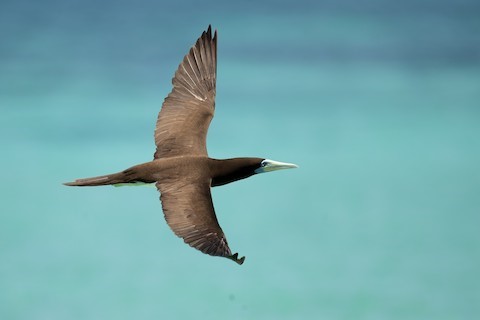
“Forster’s Booby”, S. l. plotus, male, dorsal view showing darker hood contrasting with paler-brown upperparts. (Michaelmas Cay, Queensland, Australia; January 2, 2020.) © J.J. Harrison
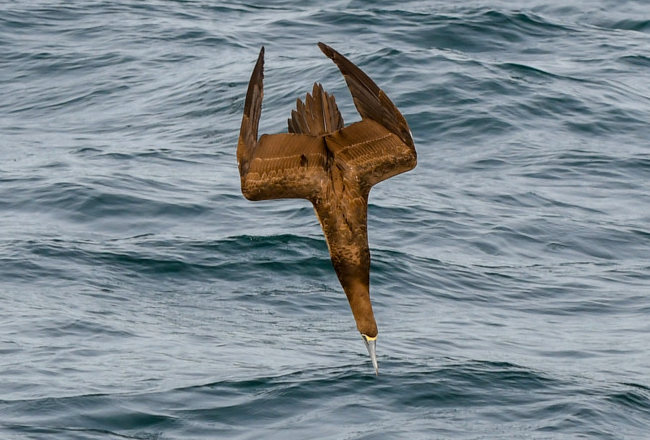
“Atlantic Booby”, S. l. leucogaster, in mid-dive about to enter the water. (Balneário Piçarras, Santa Catarina, Brazil; August 5, 2018.) © João Encarnação
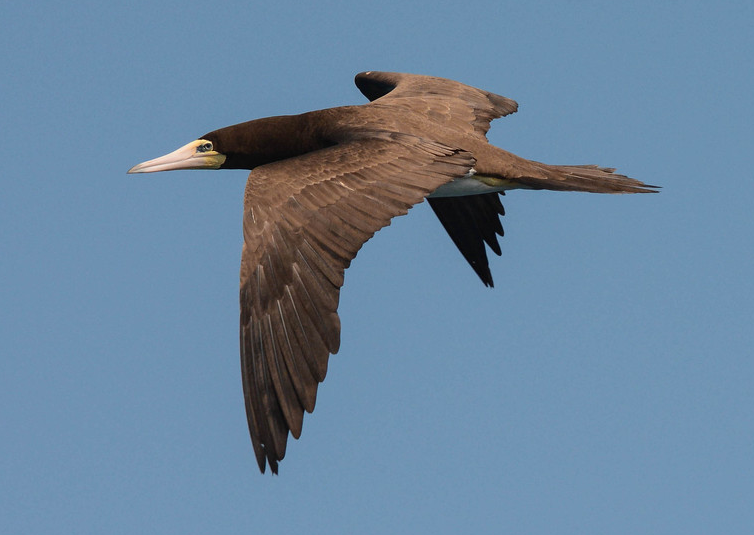
“Atlantic Booby”, S. l. leucogaster, female showing darker hood contrasting with paler-brown upperparts. (Peruíbe, São Paulo, Brazil; August 24, 2014.) © Guto Balieiro

“Forster’s Booby”, S. l. plotus, male, dorsal view showing slightly darker brown hood. (Offshore between Torishima and the Ogasawara Islands, Japan; May 27, 2017.) © Lars Petersson

“Forster’s Booby”, S. l. plotus, female. (Offshore from the Ogasawara Islands, Japan; August 8, 2020.) © Yann Muzika
Viewed ventrally in flight, the forms are more distinguishable, including the females, based on the amount of white in their underwing coverts. Their underwings are mostly dark-brown with contrasting bright-white coverts that extend out to the wrist—but with a wider brown bar on the leading edge starting midway along the secondaries.
On “Forster’s” the coverts are mostly white out to the wrist, whereas on “Brewster’s” the coverts are white near the body, then mostly dark with a narrow white central strip extending out to the wrist—usually with a thin dark streak across the middle of the coverts.
Overall, the extent of white on “Atlantic’s” underwing coverts is about intermediate between the whiter “Forster’s” and darker “Brewster’s”—so females of the two Pacific forms can often be separated on this basis, but both can be difficult to distinguish from female “Atlantic”. The differences in shading can appear pronounced in photographs, but are often difficult to detect under field conditions.
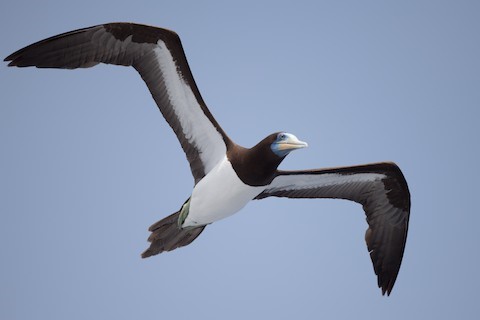
“Forster’s Booby”, S. l. plotus, male showing extensively white underwing coverts. (Offshore south of Chichijima, Ogasawara Islands, Japan; August 5, 2020.) © Yann Muzika

“Atlantic Booby”, S. l. leucogaster, male showing characteristic underwing pattern. (Fernando de Noronha, Brazil; December 18, 2016.) © Celso B. Almeida
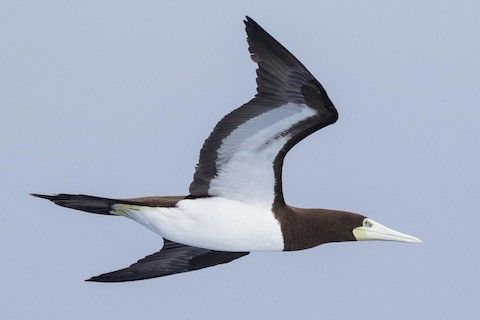
“Forster’s Booby”, S. l. plotus, female—note mostly white underwing coverts with dark “spurs” projecting into them. (Southeast of Necker Island, Hawaii; March 30, 2020.) © Eric VanderWerf
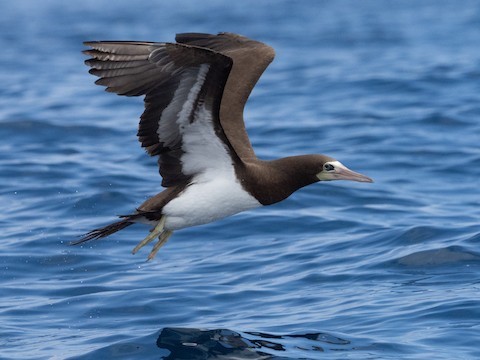
“Brewster’s Booby”, S. l. brewsteri, female, showing distinctive pattern on underwing secondary coverts. (Lower Nine Mile Bank, offshore from San Diego, California; May 28, 2021.) © Owen Sinkus

“Atlantic Booby”, S. l. leucogaster, male showing characteristic underwing pattern. (Ilha Queimada Pequena, São Paulo, Brazil; July 25, 2020.) © Eduardo Bergo
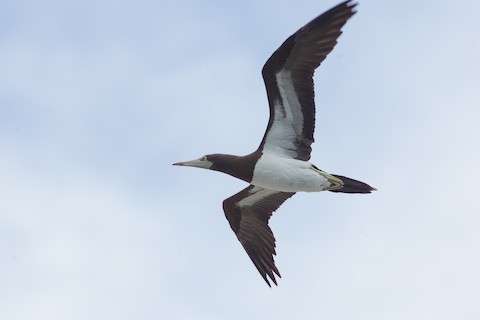
“Brewster’s Booby”, S. l. brewsteri, female. (Isla Peña Blanca, Colima, Mexico; February 2, 2005.) © Simon Colenutt
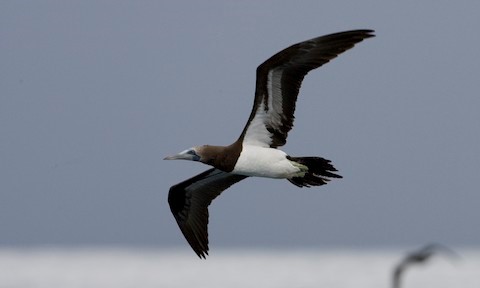
“Brewster’s Booby,” S. l. etesiaca, male. (Offshore from Punta Marenco, Puntarenas, Costa Rica; November 17, 2008.) © Brian Sullivan
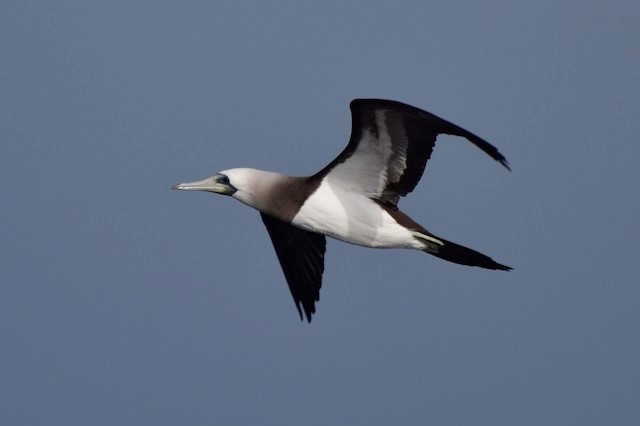
“Brewster’s Booby”, S. l. brewsteri, male. (Offshore from San Diego, California; January 1, 2018.) © Max Leibowitz
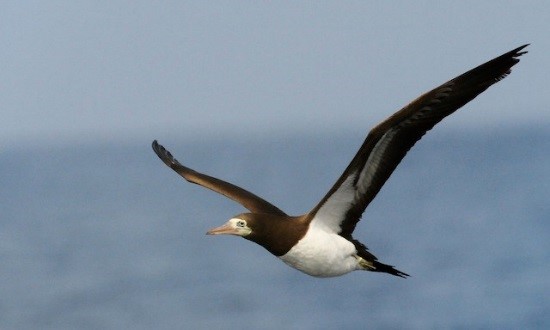
“Brewster’s Booby,” S. l. etesiaca, female. (Offshore from the Nicoya Peninsula, Costa Rica; November 21, 2010.) © Luke Seitz

“Atlantic Booby”, S. l. leucogaster, male in a dramatic aerial posture, showing characteristic underwing pattern. (Laguna, Santa Catarina, Brazil; August 15, 2013.) © Orlando Machado
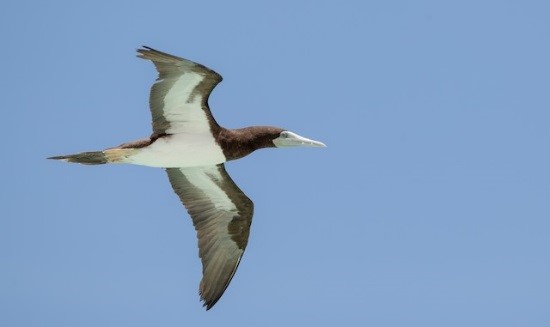
“Forster’s Booby”, S. l. plotus, female—note mostly white underwing coverts with dark “spurs” projecting into them. (Michaelmas Cay, Queensland, Australia; December 2, 2017.) © Ian Davies

“Forster’s Booby”, S. l. plotus, male showing extensively white underwing coverts. (Northern Mariana Islands; April 12, 2009.) © Nigel Voaden
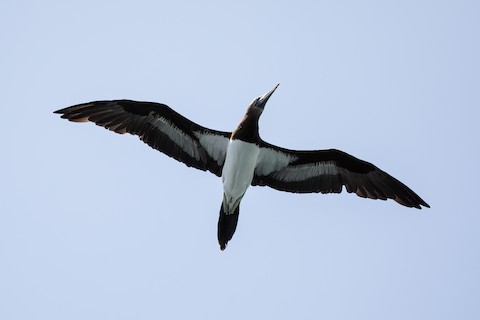
“Brewster’s Booby”, S. l. brewsteri, male. (Puerto Angel, Oaxaca, Mexico; March 25, 2017.) © Nick Athanas

“Brewster’s Booby”, S. l. brewsteri, male. (Marina Vallarta, Puerto Vallarta, Jalisco, Mexico; December 21, 2016.) © Cole Gaerber

“Atlantic Booby”, S. l. leucogaster, male showing characteristic underwing pattern. (Florianópolis, Santa Catarina, Brazil; June 20, 2015.) © Paulo Fernando Bertagnolli

“Forster’s Booby”, S. l. plotus, male showing extensively white underwing coverts. (Tench Island, New Ireland, Papua New Guinea; July 13, 2014.) © Lars Petersson
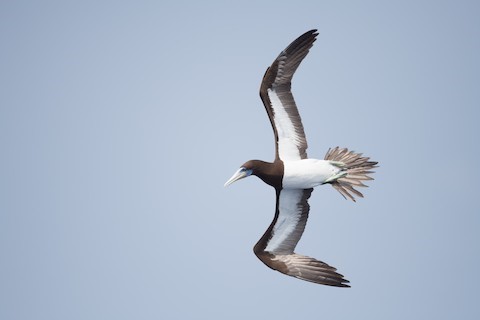
“Forster’s Booby”, S. l. plotus, male showing extensively white underwing coverts. (Offshore south of Chichijima, Ogasawara Islands, Japan; August 5, 2020.) © Yann Muzika
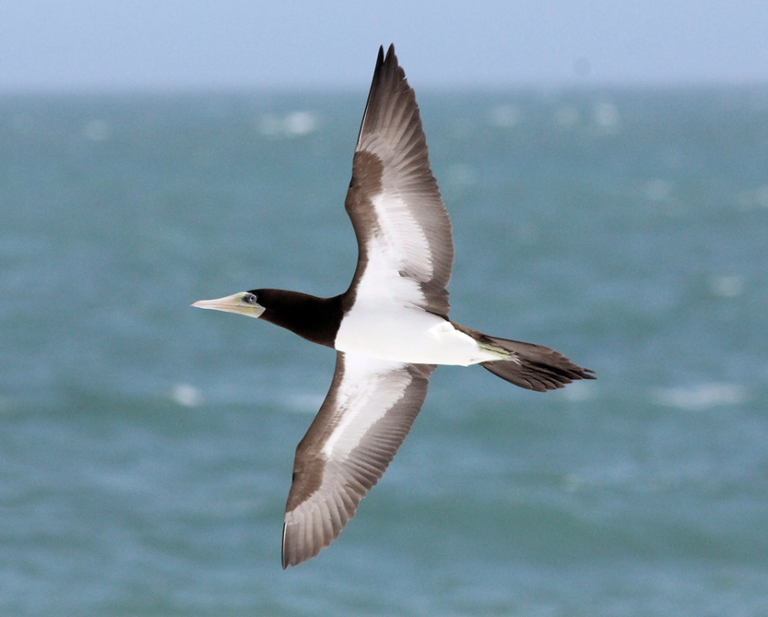
“Atlantic Booby”, S. l. leucogaster, sex indeterminate, in strong lighting which makes the underwing appear whiter then usual. (Praia de Itaipuaçu, Maricá, Rio de Janeiro, Brazil; November 3, 2013.) © Sávio Bruno
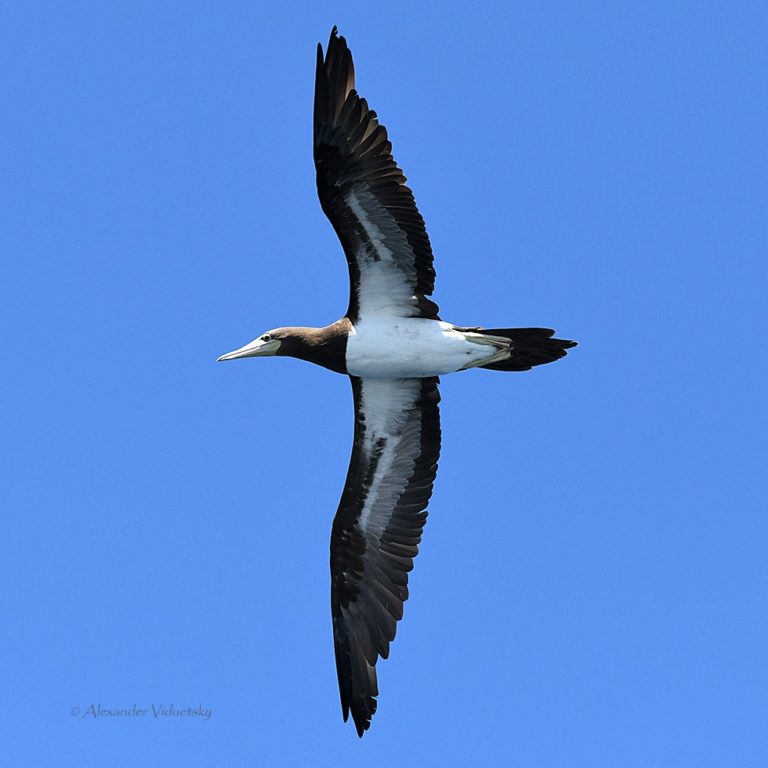
“Brewster’s Booby,” S. l. brewsteri, female. (Santa Barbara Island, California; July 12, 2020.) © Alexander Viduetsky
Immature Plumages. Before attaining full adult plumage, Brown Boobies go through a progression of changes in plumage and bare parts coloration.
Juveniles are almost entirely medium-to-dark brown with a dark-gray bill and facial skin.

“Atlantic Booby”, S. l. leucogaster, juvenile. (West Bay, Grand Cayman; October 7, 2018.) © Danielle Bouchard

“Atlantic Booby”, S. l. leucogaster, juvenile. (Pleasure Island, Port Arthur, Texas; January 30, 2020.) © Albert Ribes

“Atlantic Booby”, S. l. leucogaster, juvenile. (St. Augustine Beach, Florida; March 20, 2015.) © David W. Foster
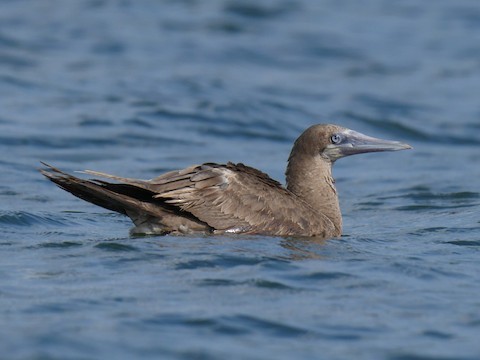
“Atlantic Booby”, S. l. leucogaster, juvenile. (Lake Onota, Pittsfield, Massachusetts; August 17, 2018.) © Linda Merry
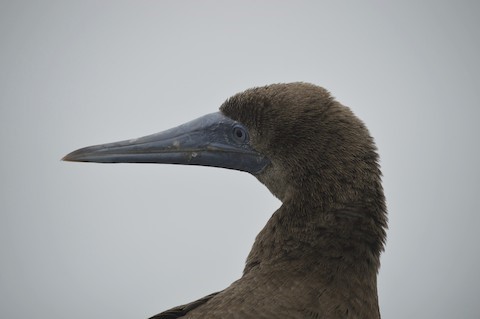
“Atlantic Booby”, S. l. leucogaster, juvenile. (St. Augustine Beach, Florida; March 20, 2015.) © David W. Foster
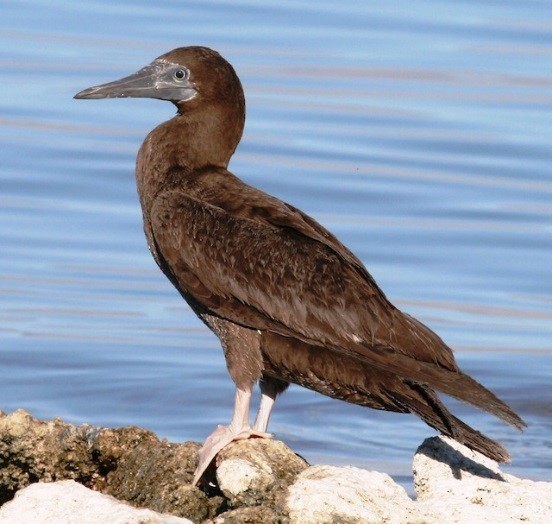
“Brewster’s Booby”, S. l. brewsteri, juvenile. (Salton Sea State Recreation Area, California; September 3, 2010.) © Tom Benson
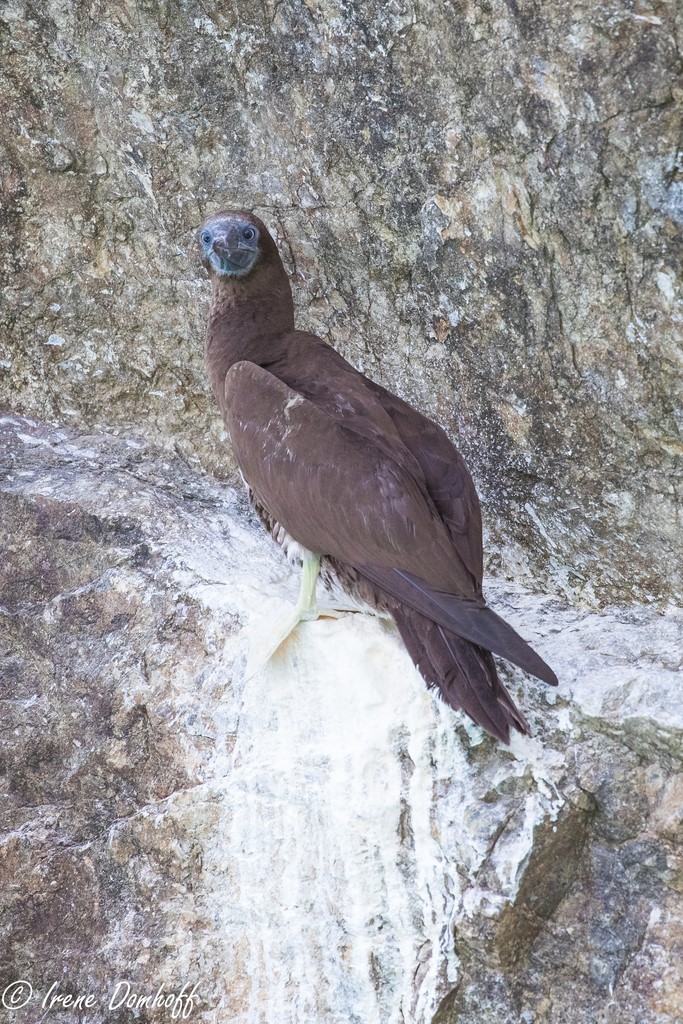
“Brewster’s Booby,” S. l. etesiaca, immature. (Punta Salsipuedes, Puntarenas, Costa Rica; March 7, 2020.) © Irene Domhoff
As they age, the belly and underwing linings become progressively whiter, and the bill and facial skin lighten. A pronounced line of demarcation between the solid brown chest and paler (eventually white) belly is noticeable at all stages after juvenile.
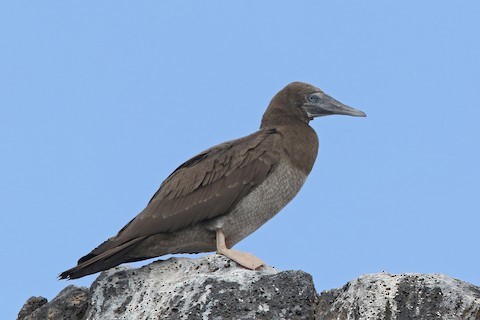
“Atlantic Booby”, S. l. leucogaster, immature. (Ilhéu Raso, Cape Verde; March 20, 2018.) © Volker Hesse
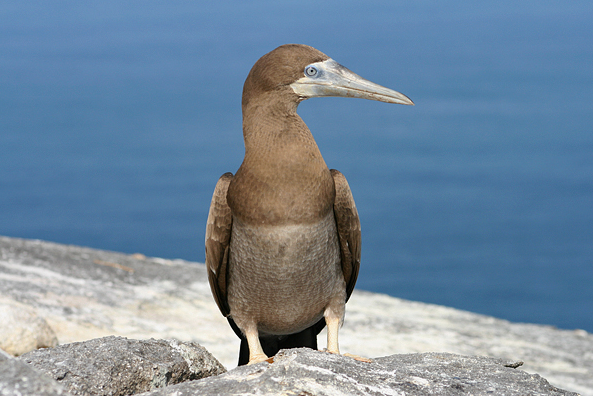
“Atlantic Booby”, S. l. leucogaster, immature. (Itanhaém, São Paulo, Brazil; August 23, 2007.) © Arthur Macarrão
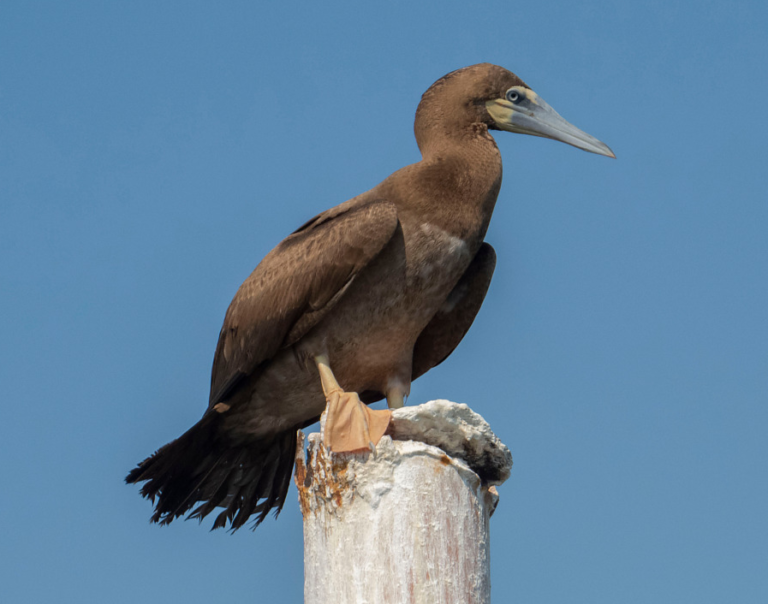
“Atlantic Booby”, S. l. leucogaster, immature. (Guapimirim, Rio de Janeiro, Brazil; October 2, 2020.) © Gustavo Quintanilha
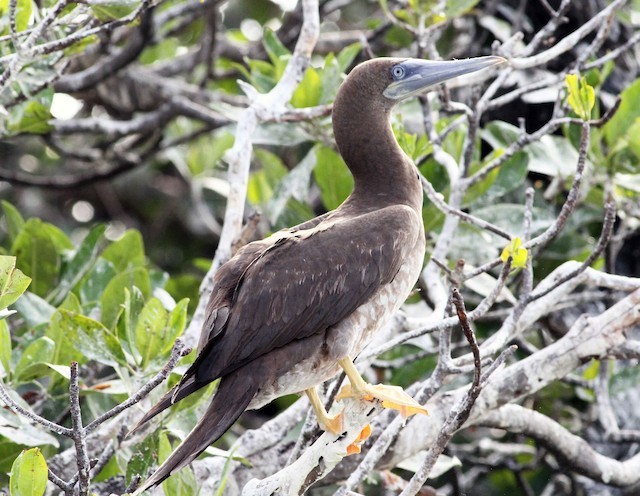
“Atlantic Booby”, S. l. leucogaster, immature. (Man-O’-War Caye, Belize; February 27, 2017.) © Cindy Franklin

“Brewster’s Booby,” S. l. brewsteri, immature. (Elephant Rock, Nayarit, Mexico; March 31, 2017.) © Skip Russell
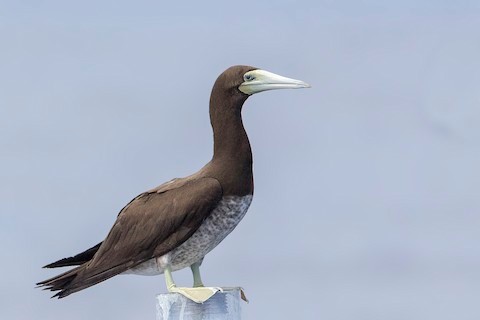
“Forster’s Booby”, S. l. plotus, subadult female. (Offshore from Kailua-Kona, Big Island, Hawaii; September 14, 2018.) © Bradley Hacker
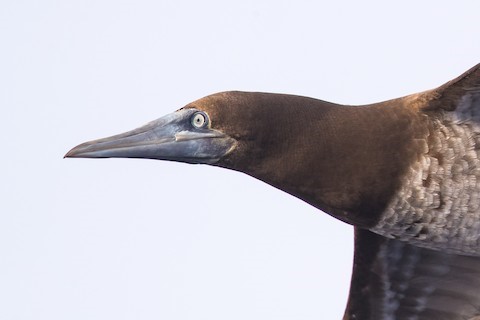
“Brewster’s Booby”, S. l. brewsteri, immature. (Offshore from San Diego, California; October 21, 2018.) © Ryan Sanderson

“Atlantic Booby”, S. l. leucogaster, immature. (Laje de Santos State Marine Park, São Paulo, Brazil; November 26, 2014.) © Francisco Luiz Vicentini Neto
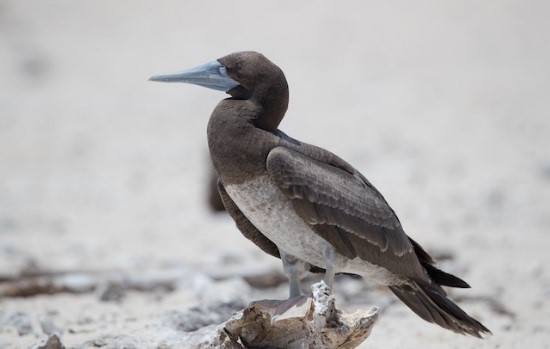
“Forster’s Booby”, S. l. plotus, immature. (Michaelmas Cay, Great Barrier Reef, Queensland, Australia; December 2, 2017.) © Ian Davies

“Atlantic Booby”, S. l. leucogaster, immature. (Doniphan, Missouri; August 11, 2020.) © Pete Monacell

“Forster’s Booby”, S. l. plotus, immature, with brown coloration appearing bleached out—it is not clear whether this is due to the lighting or aberrant plumage. (Christmas Island; July 29, 2017.) © Hickson Fergusson

“Atlantic Booby”, S. l. leucogaster, subadult male. (Ilhabela, São Paulo, Brazil; June 25, 2020.) © Octavio Campos Salles
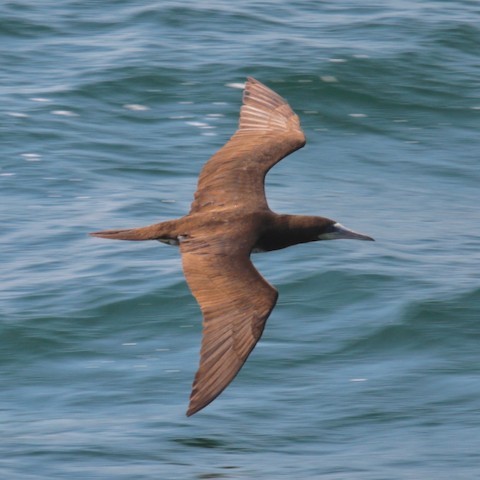
“Brewster’s Booby,” S. l. etesiaca, subadult female. (Gulf of Nicoya, Costa Rica; May 8, 2018.) © Armand Munteanu

“Atlantic Booby”, S. l. leucogaster, immature. (Offshore from Castries, St. Lucia; March 28, 2018.) © Luiz Moschini

“Atlantic Booby”, S. l. leucogaster, immature. (Ilhabela, São Paulo, Brazil; October 19, 2019.) © Silvia Faustino Linhares
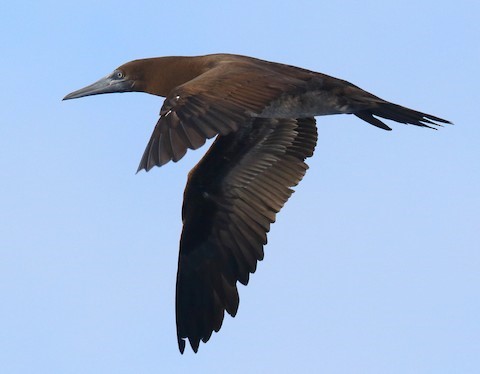
“Brewster’s Booby”, S. l. brewsteri, immature. (Offshore from San Diego, California; October 21, 2018.) © Greg Gillson
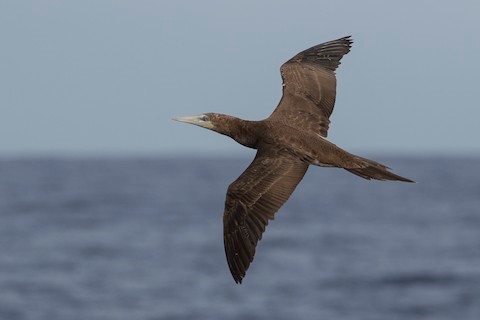
“Forster’s Booby”, S. l. plotus, subadult. (Offshore from Kailua-Kona, Big Island, Hawaii; March 24, 2019.) © Jacob Drucker

“Atlantic Booby”, S. l. leucogaster, juvenile. (Cabo Rojo, Puerto Rico; January 30, 2010.) © Steve Metz

“Atlantic Booby”, S. l. leucogaster, immature, showing crisp contrast between darker hood and paler upperparts. (Offshore from Biscayne Bay, Florida; September 13, 2020.) © Robert Gundy
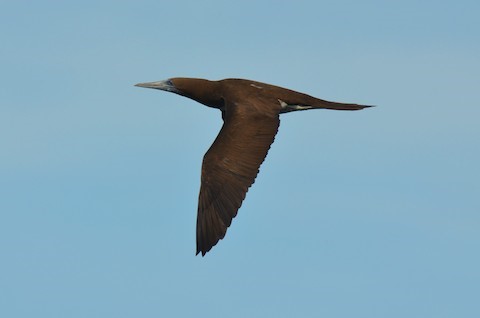
“Brewster’s Booby,” S. l. brewsteri, immature. (Marina Norte de La Paz, Baja California Sur, Mexico; October 3, 2019.) © Jeff Sexton

“Brewster’s Booby”, S. l. brewsteri, immature male, far west of its normal range—distinguished from the expected “Forster’s” by pale feathering on the face. (Offshore south of Nihoa Island, Hawaii; April 5, 2018.) © Eric VanderWerf
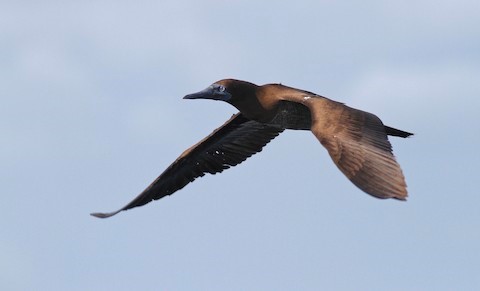
“Brewster’s Booby,” S. l. etesiaca, immature. (Playa Garza, Guanacaste, Costa Rica; December 29, 2017.) © Miles Brengle
Immature “Forster’s” differ from those of the other forms in that their underwing coverts appear to turn white sooner than the belly feathers. On “Atlantic” and “Brewster’s”, the underwing coverts generally match the belly coloration. (This may be a useful distinction for the identification of immature boobies in the Pacific.)
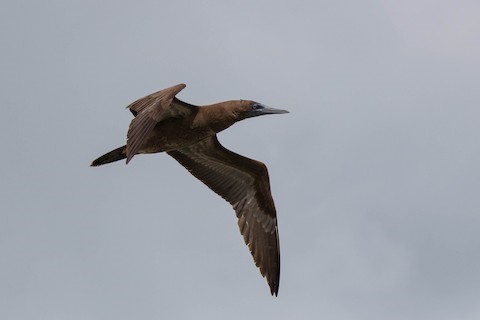
“Atlantic Booby”, S. l. leucogaster, juvenile. (Belize City, Belize; January 23, 2020.) © Hernan Riverol
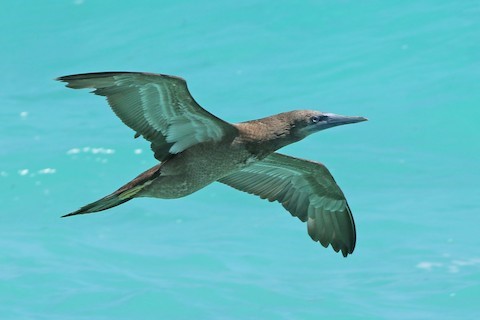
“Atlantic Booby”, S. l. leucogaster, immature. (Cabo Rojo, Dominican Republic; April 11, 2019.) © Volker Hesse

“Forster’s Booby”, S. l. plotus, immature female, showing extensively white underwing coverts. (Pauwalu Point, Maui, Hawaii; February 1, 2020.) © Zeke Smith
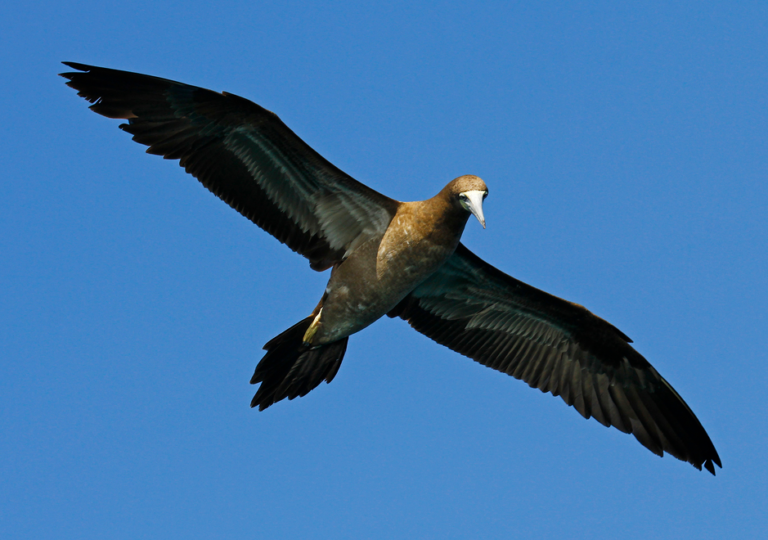
“Atlantic Booby”, S. l. leucogaster, immature. (Florianópolis, Santa Catarina, Brazil; August 2, 2015.) © Carmen Lúcia Bays Figueiredo

“Forster’s Booby,” S. l. plotus, immature. (Northeast Point, Christmas Island; November 10, 2016.) © Bill Bacon

“Forster’s Booby,” S. l. plotus, subadult female. (Kekaha Beach Park, Kauai, Hawaii; February 18, 2018.) © Sharif Uddin

“Brewster’s Booby,” S. l. brewsteri, subadult male. (Nine Mile Bank, offshore from San Diego, California; January 1, 2015.) © Greg Gillson

“Atlantic Booby”, S. l. leucogaster, subadult female. (St. Thomas, U.S. Virgin Islands; September 27, 2005.) © Dale Pate
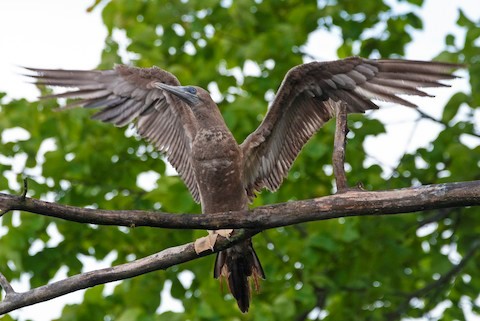
“Atlantic Booby”, S. l. leucogaster, juvenile showing almost uniformly dark underwings. (Nimisila Reservoir, Summit County, Ohio; August 29, 2020.) © Andrew Simon
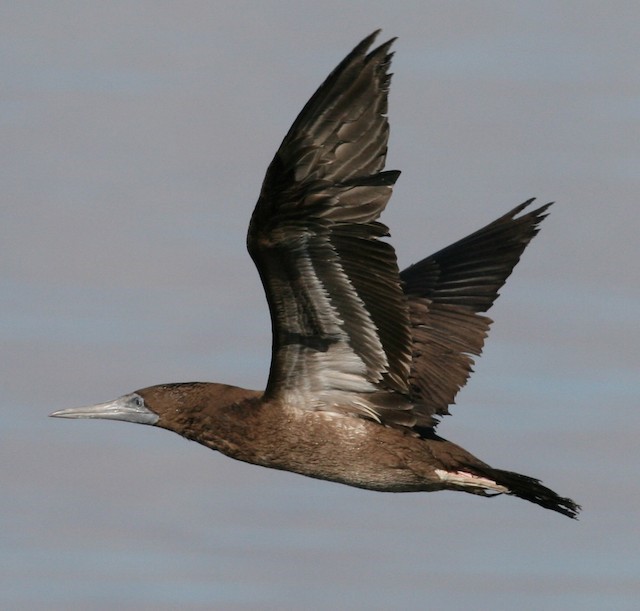
“Brewster’s Booby,” S. l. brewsteri, juvenile. (Salton Sea State Recreation Area, California; September 3, 2010.) © Tom Benson

“Atlantic Booby”, S. l. leucogaster, immature. (Offshore from Martinique; March 2, 2018.) © Brian Sullivan
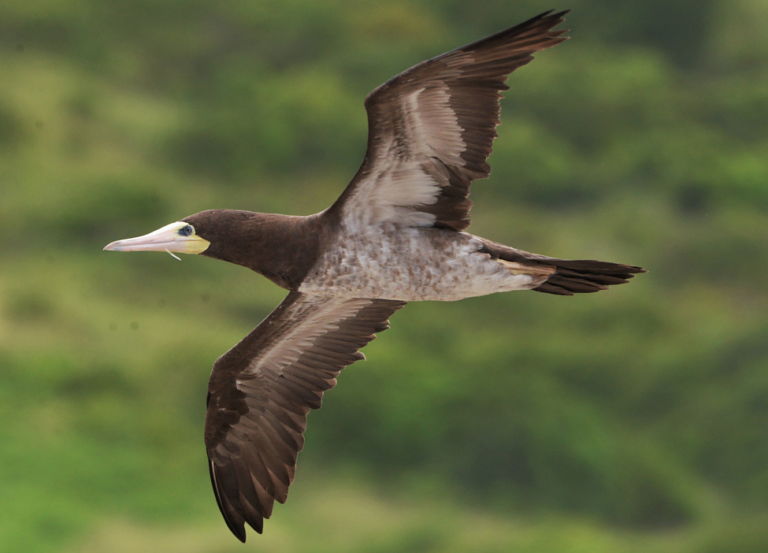
“Atlantic Booby”, S. l. leucogaster, immature female. (Fernando de Noronha, Brazil; April 12, 2019.) © Julio Machado
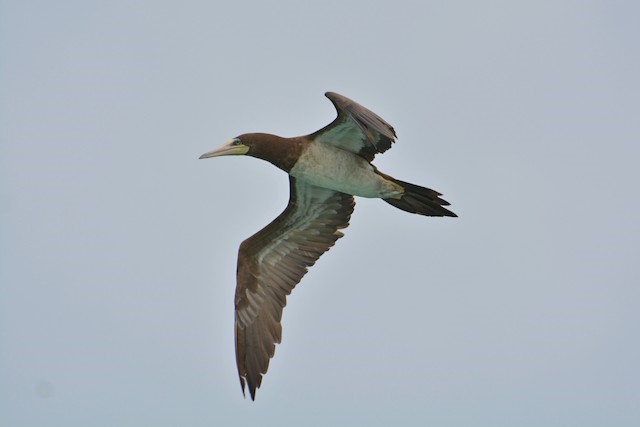
“Atlantic Booby”, S. l. leucogaster, subadult female. (Arraial do Cabo, Rio de Janeiro, Brazil; January 8, 2018.) © Oliver Prioli

“Atlantic Booby”, S. l. leucogaster, immature with atypical difference in progression of white plumage on the underwing coverts versus the belly. (Ubatuba, São Paulo, Brazil; October 31, 2009.) © João Marcelo da Costa

“Atlantic Booby”, S. l. leucogaster, immature. (Joinville, Santa Catarina, Brazil; February 4, 2014.) © Osni Sidnei Munhoz
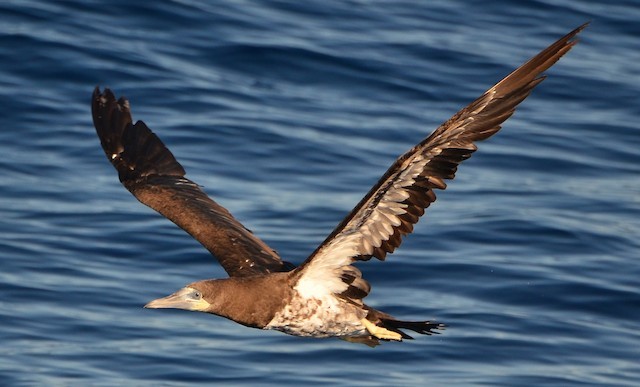
“Brewster’s Booby,” S. l. brewsteri, subadult female. (Santa Barbara Channel, California; October 10, 2015.) © Steve Tucker
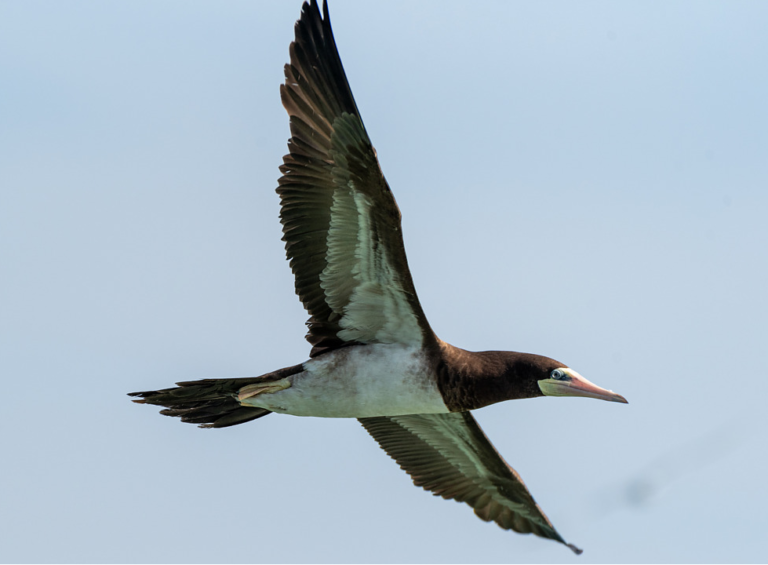
“Atlantic Booby”, S. l. leucogaster, subadult male. (Balneário Piçarras, Santa Catarina, Brazil; July 5, 2020.) © Marcos Guirado
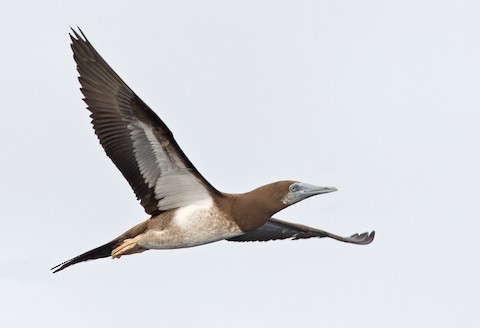
“Forster’s Booby”, S. l. plotus, immature. (Wilson Strait, Solomon Islands; July 12, 2015.) © Lars Petersson

“Atlantic Booby”, S. l. leucogaster, subadult female. (Offshore from Peniche, Portugal; December 3, 2017.) © PMDE Esteves

“Atlantic Booby”, S. l. leucogaster, subadult female. (Hogsty Reef, Bahamas; May 22, 2019.) © Hannes Leonard
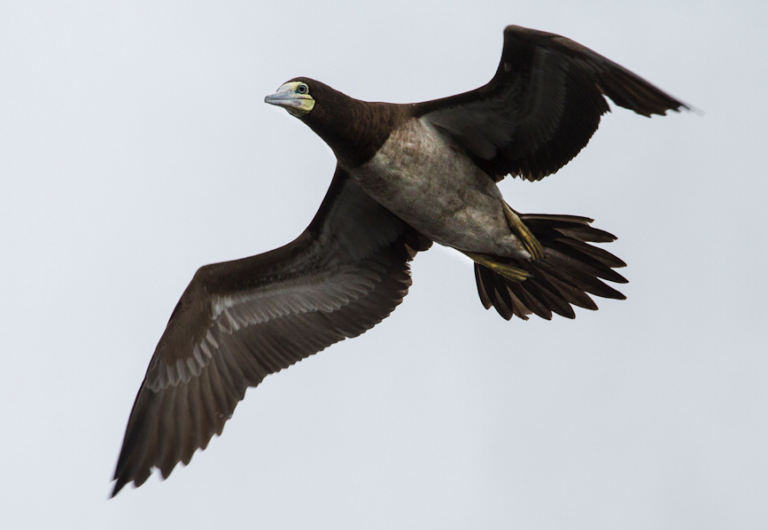
“Atlantic Booby”, S. l. leucogaster, immature female. (Cananéia, São Paulo, Brazil; July 15, 2012.) © Pepe Mélega
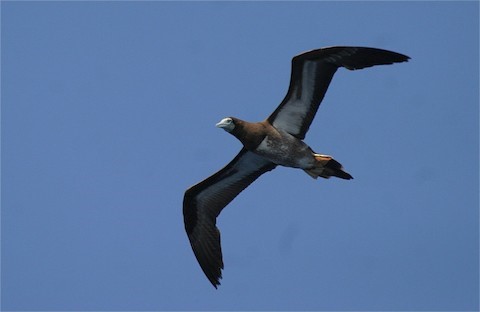
“Forster’s Booby”, S. l. plotus, immature. (Restorf Island, West New Britain, Papua New Guinea; April 6, 2007.) © Ken Havard

“Atlantic Booby”, S. l. leucogaster, immature. (Cabo Frio, Rio de Janeiro, Brazil; July 18, 2013.) © Karoline França
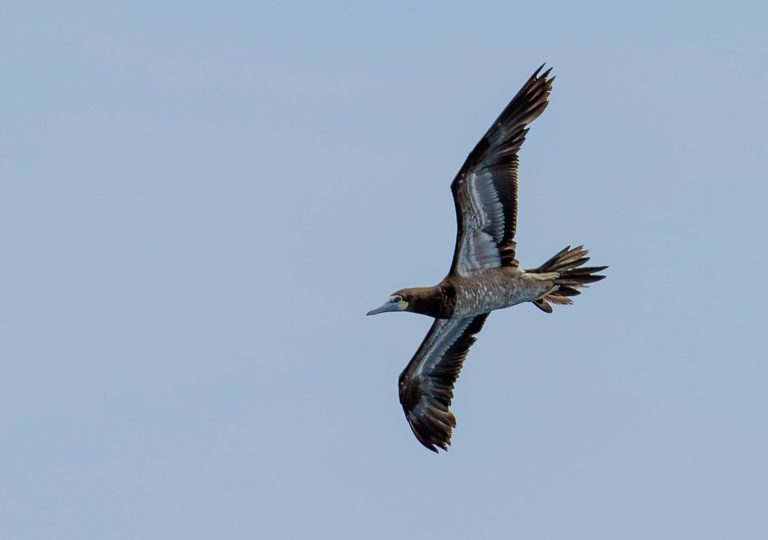
“Atlantic Booby”, S. l. leucogaster, immature. (Salvador, Bahia, Brazil; December 6, 2014.) © Vítor Barbosa
Cf. Red-footed Booby. Dark morph Red-footed Boobies, which predominate in some populations—especially in the eastern Pacific—can be all-brown, and the juveniles in particular strongly resemble juvenile and immature Brown Boobies.
Typically, juvenile Brown Boobies are darker than these Red-footeds and more uniformly colored above and below. Immature Browns become distinctive as the belly lightens because the lightened area is sharply defined, matching the adult plumage.
Most juvenile Red-footed Boobies have a perceptibly darker breastband. As they age, dark morph Red-footed Boobies turn coffee-colored rather than dark brown.
Cf. Other Juvenile Boobies. Juvenile Masked, Nazca, and Blue-footed Boobies have roughly the same pattern as adult Brown Boobies, for which they are often mistaken. Under suboptimal viewing conditions they can be indistinguishable, but if seen clearly the crisp bicolored plumage of adult Brown Boobies is unique.
Notes
Polytypic species consisting of four recognized subspecies that are divided into three distinct forms, which are sometimes regarded as separate species (e.g., Howell and Zufelt 2019): “Atlantic Booby” (leucogaster), “Forster’s Booby” (plotus), and “Brewster’s Booby” (brewsteri plus etesiaca). Males of the forms differ visibly from one another, but females are extremely similar.
References
Alderfer, J., and J.L. Dunn. 2014. National Geographic Complete Birds of North America (Second Edition). National Geographic Society, Washington, D.C.
Ascanio, D., G.A. Rodriguez, and R. Restall. 2017. Birds of Venezuela. Christopher Helm, London.
BirdLife International. 2018. Sula leucogaster. The IUCN Red List of Threatened Species 2018: e.T22696698A132590197. https://dx.doi.org/10.2305/IUCN.UK.2018-2.RLTS.T22696698A132590197.en. (Accessed July 6, 2021.)
Brazil, M. 2009. Birds of East Asia. Princeton University Press.
eBird. 2021. eBird: An online database of bird distribution and abundance. Cornell Lab of Ornithology, Ithaca, N.Y. http://www.ebird.org. (Accessed July 6, 2021.)
Fagan, J., and O. Komar. 2016. Peterson Field Guide to the Birds of Northern Central America. Houghton Mifflin Harcourt, New York.
ffrench, R. 2012. A Guide to the Birds of Trinidad & Tobago (Third Edition). Cornell University Press.
Garcia-del-Rey, E. 2011. Field Guide to the Birds of Macaronesia: Azores, Madeira, Canary Islands, Cape Verde. Lynx Editions, Barcelona.
Garcia-del-Rey, E. 2018. Birds of the Canary Islands. Christopher Helm, London.
Garrigues, R., and R. Dean. 2014. The Birds of Costa Rica: A Field Guide (Second Edition). Cornell University Press.
Harrison, P. 1983. Seabirds: An Identification Guide. Houghton Mifflin, Boston.
Hollom, P.A.D., R.F. Porter, S. Christensen, and I. Willis. 1988. Birds of the Middle East and North Africa. T & AD Poyser, Calton, England.
Howell, S.N.G., and S. Webb. 1995. A Guide to the Birds of Mexico and Northern Central America. Oxford University Press.
Howell, S.N.G., and K. Zufelt. 2019. Oceanic Birds of the World. Princeton University Press.
Kirwan, G.M., A. Levesque, M. Oberle, and C.J. Sharpe. 2019. Birds of the West Indies. Lynx Edicions, Barcelona.
Lee, D.S. and W.A. Mackin. 2009. Brown Booby. West Indian Breeding Seabird Atlas. http://www.wicbirds.net/brbo.html. (Posted April 7, 2009. Accessed July 6, 2021.)
McMullan, M., and T. Donegan. 2014, Field Guide to the Birds of Colombia (Second Edition). Fundación Proaves de Colombia, Bogotá.
Mullarney, K., L. Svensson, D. Zetterström, and P.J. Grant. 1999. Birds of Europe. Princeton University Press.
Pratt, H.D., P.L. Bruner, and D.G. Berrett. 1987. A Field Guide to the Birds of Hawaii and the Tropical Pacific. Princeton University Press.
Pyle, R.L., and P. Pyle. 2017. The Birds of the Hawaiian Islands: Occurrence, History, Distribution, and Status. Version 2 (January 1, 2017). http://hbs.bishopmuseum.org/birds/rlp-monograph/. B.P. Bishop Museum, Honolulu, Hawaii.
Ridgely, R.S., and P.J. Greenfield. 2001. The Birds of Ecuador, Volume II: Field Guide. Cornell University Press.
Ridgely, R.S., and J.A. Gwynne. 1989. A Guide to the Birds of Panama (Second Edition). Princeton University Press.
Robson, C. 2002. Birds of Thailand. Princeton University Press.
Schulenberg, T.S., D.F. Stotz, D.F. Lane, J.P. O’Neill, and T.A. Parker. 2007. Birds of Peru. Princeton University Press.
Sinclair, I., P. Hockey, W. Tarboton, and P. Ryan. 2011. Birds of Southern Africa (Fourth Edition). Random House Struik (Pty) Ltd. Cape Town, South Africa.
van Perlo, B. 2009. A Field Guide to the Birds of Brazil. Oxford University Press.
Wells, J.V., and A.C. Wells. 2017. Birds of Aruba, Bonaire, and Curaçao. Cornell University Press.
Wikiaves. 2021. Atobá-pardo, https://www.wikiaves.com.br/wiki/atoba-pardo. (Accessed July 6, 2021.)
Xeno-Canto. 2021. Brown Booby – Sula leucogaster. https://www.xeno-canto.org/species/Sula-leucogaster. (Accessed July 6, 2021.)

